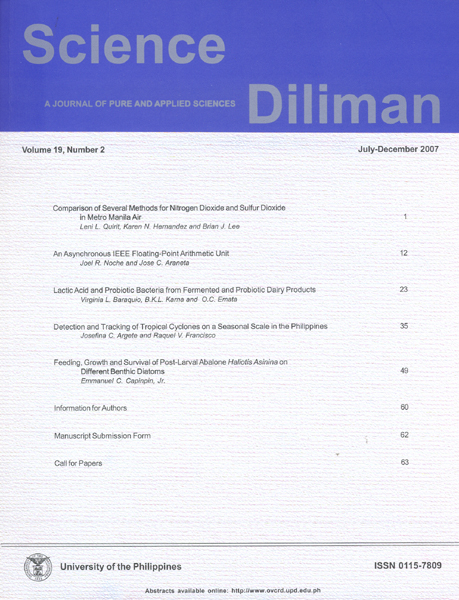Lactic Acid and Probiotic Bacteria from Fermented
Abstract
Lactic acid and probiotic bacteria were enumerated and isolated from commercially available yoghurt and probiotic milk products. Lactobacillus delbrueckii ssp. bulgaricus were enumerated and isolated using MRS agar incubated anaerobically at 37oC for 72 hrs. M17 agar was used for the enumeration and isolation of Streptococcus thermophilus incubated aerobically at 37°C for 48 hrs. MRS agar and modified MRS agar (MRS + L-cysteine + LiCl + Na propionate) were used for the enumeration and isolation of probiotic bacteria. Both were incubated anaerobically at 37°C for 72 hrs. Morphological, physiological and biochemical reactions were used to characterize the isolates.Str. thermophilus counts ranged from 2.6 x 1011 to 2.9 x 1020 CFU/g with Fruit Yoghurt (FY) having the highest count and Yoghurt Natural (YN) with the lowest count. Highest Lactobacillus delbrueckii ssp. bulgaricus count was obtained in Duo Yoghurt (DY), 1.1 x 109 and lowest in Yoghurt Drink (YD), 8.0 x 107 CFU/g. The highest probiotic bacterial count of 2.3 x 108 was obtained in Yakult (YK) and Neslac (Nes) showed the lowest, 1.6 x 102 CFU/g. The viable counts of all the products examined met the prescribed minimum viable count of 105 to 106 CFU/g for the claimed health benefits for the consumer except for Chamyto Plain (CP), Nes and Nan-2 (Nan).
Morphological, physiological and biochemical characteristics showed that the following genera and species were present Pediococcus acidilactici (YN), P. pentosaceus (FY), Lactobacillus delbrueckii delbrueckii and L. brevis in Non Fat High Calcium Yoghurt (NC), L. acidophilus and L. delbrueckii delbrueckii (DY, YD), P. damnosus and P. pentosaceus in Chamyto Orange (CO), L. delbrueckii bulgaricus, L. acidophilus, and L. delbrueckii delbrueckii (CP), L. para. paracasei (YK) and Bifidobacterium ssp. (Nes and Nan).Of the 28 isolates characterized in this study, 15 were Lactobacillus (5 species), 5 were Pediococcus (3 species), 6 were Bifidobacterium (species not identified), and 2 were Actinomyces israelii (1 species).
Published
2008-01-15
Issue
Section
Articles
Keywords
LAB; lactic acid bacteria; probiotic; fermented dairy products
Submission of a manuscript implies: that the work described has not been published before (except in the form of an abstract or as part of a published lecture, review, or thesis); that it is not under consideration for publication elsewhere; that its publication has been approved by all co-authors, if any, as well as by the responsible authorities at the institute where the work has been carried out; that, if and when the manuscript is accepted for publication, the authors agree to the automatic transfer of the copyright to the publisher; that the manuscript will not be published elsewhere in any language without the consent of the copyright holders; that written permission of the copyright holder is obtained by the authors for material used from other copyrighted sources; and that any costs associated with obtaining this permission are the authors’ responsibility.



